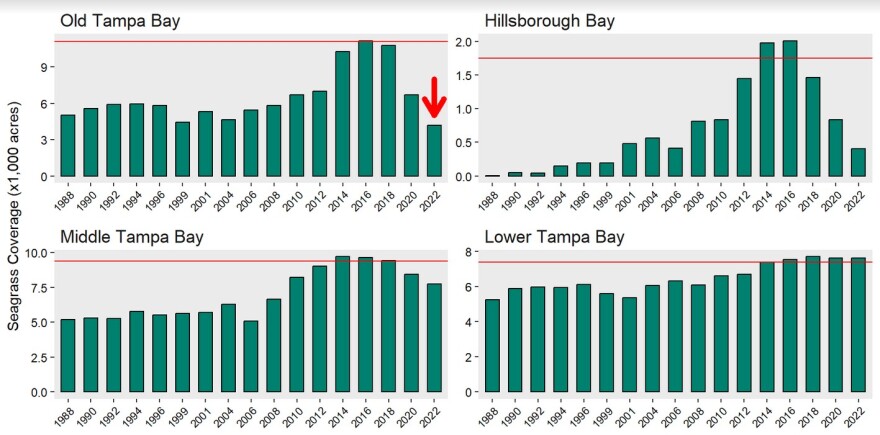After decades of being on the mend, the amount of seagrasses in Tampa Bay has decreased for three years in a row. That's bad news for marine life, which depends on these grasses as a vital food source.
Between 2020 and 2022, seagrasses throughout Tampa Bay declined by more than 4,000 acres, or 12%. The bay has lost nearly 30% of its seagrasses since peak conditions were recorded in 2016.
The likely culprit is rain, which brings nutrients and sediments into the bay from rivers and storm drains. That clouds the water, preventing sunlight from reaching seagrasses.
"We're in a period of higher hydrologic inputs. That might just be higher rainfall conditions over the past decade, increasing the amount of storm water that's discharged into Tampa Bay," said Ed Sherwood, executive director of the Tampa Bay Estuary Program. "That could be tied to climate change impacts — definitely warmer water temperatures in the upper bay segments might also be adding stresses."
All that rain means nutrients from lawn clippings, fertilizer and street debris is swept into storm drains and empties into the bay.
"Right now, the biggest thing we need to focus on is removing the amount of nutrients going into Tampa Bay, to improve water clarity and prevent harmful algal blooms and other algal blooms from occurring that could further cloud the water," Sherwood said.
He says you can help by making sure lawn clippings don't make their way into stormwater drains, and don't fertilize your lawn during the summer rainy season
Upper Tampa Bay seems to be the most affected, Sherwood said. That arm of the bay does not get a lot of flushing from the Gulf, which would take many of these nutrients out to sea. That area has been plagued in the summertime by a type of algae known as pyrodinium.

Here's more information from the Tampa Bay Estuary Program:
The majority of those losses occurred in the upper portions of the bay, which are more sensitive to freshwater inflow from rivers and stormwater runoff.
Old Tampa Bay and Hillsborough Bay were down 2,518 acres (38%) and 428 acres (51%), respectively. Bay managers have expressed concerns about recurring summertime algae blooms and water clarity trends affecting seagrass in Old Tampa Bay for several years. Now, seagrass coverage in Old Tampa Bay is at an all-time historic low.
Research focused on additional seagrass stressors, such as warming water temperatures and obstructions to tidal circulation in Old Tampa Bay, are underway and guiding restoration efforts.
Recent seagrass acreage estimates are based on imagery collected during the winter of 2021-2022, after the emergency discharges from Piney Point and subsequent red tide bloom but prior to the passage of Hurricane Ian.
Notably, losses in middle Tampa Bay were concentrated along the southeastern shore from Bishop Harbor to Apollo Beach, an area of particular interest for the coordinated environmental monitoring response following the Piney Point event.




